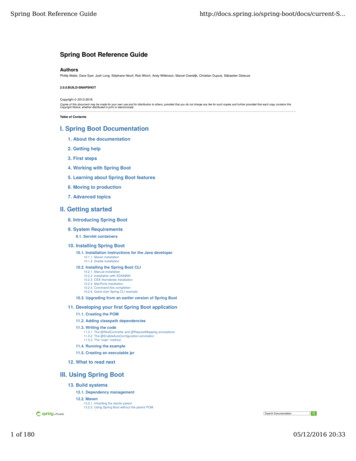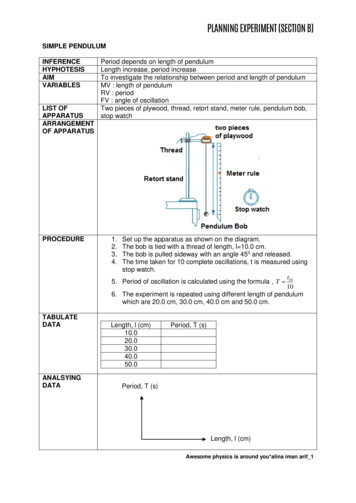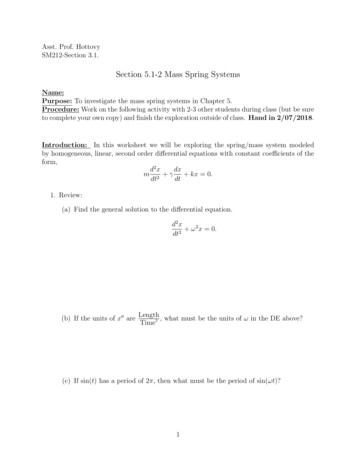
Transcription
spring-security#springsecurity
Table of ContentsAbout1Chapter 1: Getting started with tion or Setup2Spring Securitiy to protect REST API endpoints2Spring-Security using spring-boot and JDBC Authentication4Hello Spring Security7Securing application7Running Secure web application9Displaying user name9Logging out10Chapter 2: Spring Security config with java (not XML)11Introduction11Syntax11Examples11Basic spring security with annotation, SQL datasourceChapter 3: Spring Security 4
AboutYou can share this PDF with anyone you feel could benefit from it, downloaded the latest versionfrom: spring-securityIt is an unofficial and free spring-security ebook created for educational purposes. All the contentis extracted from Stack Overflow Documentation, which is written by many hardworking individualsat Stack Overflow. It is neither affiliated with Stack Overflow nor official spring-security.The content is released under Creative Commons BY-SA, and the list of contributors to eachchapter are provided in the credits section at the end of this book. Images may be copyright oftheir respective owners unless otherwise specified. All trademarks and registered trademarks arethe property of their respective company owners.Use the content presented in this book at your own risk; it is not guaranteed to be correct noraccurate, please send your feedback and corrections to info@zzzprojects.comhttps://riptutorial.com/1
Chapter 1: Getting started with springsecurityRemarksThis section provides an overview of what spring-security is, and why a developer might want touse it.It should also mention any large subjects within spring-security, and link out to the related topics.Since the Documentation for spring-security is new, you may need to create initial versions ofthose related topics.VersionsVersionRelease 4.1.42016-12-214.2.02016-11-10ExamplesInstallation or SetupDetailed instructions on getting spring-security set up or installed.Spring Securitiy to protect REST API endpointsAdd below entries in pom.xml. dependency groupId org.springframework.security /groupId artifactId spring-security-web /artifactId version 3.1.0.RELEASE /version /dependency dependency groupId org.springframework.security /groupId artifactId spring-security-config /artifactId version 3.1.0.RELEASE /version https://riptutorial.com/2
/dependency Important for Spring version greater than 3.1:Bean creation error for org.springframework.security.filterChains comes when you are usingSpring version higher than 3.1 and have not added dependencies manually for spring-aop, springjdbc, spring-tx and spring-expressions in your pom.xml.Add below entries in Spring context. We want to protect two REST endpoints (helloworld &goodbye). Adjust XSD version according to Spring version. ?xml version "1.0" encoding "UTF-8"? beans xmlns :xsi ecurity lns:context :schemaLocation hema/security/spring-security3.1.xsd" security:http auto-config 'true' create-session "never" security:intercept-url pattern "/helloworld/**" access "ROLE USER" / security:intercept-url pattern "/goodbye/**" access "ROLE ADMIN" / security:intercept-url pattern "/**" access "IS AUTHENTICATED ANONYMOUSLY" / security:http-basic / /security:http security:authentication-manager security:authentication-provider security:user-service security:user name "username1" password "password1"authorities "ROLE USER" / security:user name "username2" password "password2"authorities "ROLE ADMIN" / /security:user-service /security:authentication-provider /security:authentication-manager /beans Add below entries in web.xml. !-- Spring security-- filter filter-name springSecurityFilterChain /filter-name filter-class xy /filter-class /filter filter-mapping filter-name springSecurityFilterChain /filter-name url-pattern /* /url-pattern /filter-mapping listener listener-class ner /listener-class https://riptutorial.com/3
/listener context-param param-name contextConfigLocation /param-name param-value classpath:security-context.xml /param-value /context-param Spring-Security using spring-boot and JDBC AuthenticationSuppose you want to prevent unauthorized users to access the page then you have to put barrierto them by authorizing access. We can do this by using spring-security which provides basicauthentication by securing all HTTP end points. For that you need to add spring-securitydependency to your project, in maven we can add the dependency as: dependency groupId org.springframework.boot /groupId artifactId spring-boot-starter-security /artifactId /dependency Here's a security configuration that ensures that only authenticated users can ESS OVERRIDE ORDER)public class SecurityConfig extends WebSecurityConfigurerAdapter {@AutowiredDataSource datasource;@Overrideprotected void configure(HttpSecurity http) throws Exception d void configure(AuthenticationManagerBuilder auth) throws Exception passwordEncoder(passwordEncoder());}@Beanpublic PasswordEncoder passwordEncoder() {PasswordEncoder encoder new BCryptPasswordEncoder();return encoder;https://riptutorial.com/4
}}ConfigurationDescription@ConfigurationIndicates that the class canbe used by the Spring IoCcontainer as a source ofbean definitions.@Order (SecurityProperties.ACCESS OVERRIDE ORDER)Override the access ruleswithout changing any otherautoconfigured features.Lower values have higherpriority.WebSecurityConfigurerAdapterThe SecurityConfig classextends and overrides acouple of its methods to setsome specifics of the securityconfiguration.of DataSourceProvide factory forconnections to the physicaldata source.configure(HttpSecurity)Overridden method defineswhich URL paths should besecured and which shouldnot.authorizeRequests().anyRequest() .fullyAuthenticated()Indicates to spring that allrequest to our applicationrequires to be authenticated.formLogin()Configures a form error").permitAll()Specifies the location of thelog in page and all usersshould be permitted toaccess the l("/login?logout").permitAll()The URL to redirect to afterlogout has occurred. Thedefault is /login?logout.csrf()Used to prevent Cross SiteRequest Forgery, CSRF@Autowiredhttps://riptutorial.com/5
ConfigurationDescriptionprotection is ilder){}Overridden method to definehow the users atasource)Indicates to spring that weare using ())Indicates to spring that weare using a passwordencoder to encode ourpasswords. (A bean iscreated to return the choiceof password Encoder, we areusing BCrypt in this case)Notice that we have not configured any table name to be used or any query, this is because springsecurity by default looks for the below tables:create table users (username varchar(50) not null primary key,password varchar(255) not null,enabled boolean not null) ;create table authorities (username varchar(50) not null,authority varchar(50) not null,foreign key (username) references users (username),unique index authorities idx 1 (username, authority));Insert the following rows into the above tables:INSERT INTO authorities(username,authority)VALUES ('user', 'ROLE ADMIN');INSERT INTO users(username,password,enabled)VALUES('user', ' 2a 10 R4m', '1');The username in our case is user and the password is also user encrypted with BCrypt algorithmFinally, Configure a datasource in the application.properties for spring boot to use:spring.datasource.url e.username rootspring.datasource.password Welcome123https://riptutorial.com/6
Note: Create and configure a login controller and map it to the path /login and point your loginpage to this controllerHello Spring SecurityNote 1: You need some prior knowledge about java servlet page(JSP) and ApacheMaven before you start this examples.Start the web server (like Apache tomcat) with existing web project or create one.Visit the index.jsp.Anybody can access that page, it's insecure!Securing application1. Update Maven dependenciesAdding dependencies to your pom.xml filepom.xml dependency groupId org.springframework.security /groupId artifactId spring-security-web /artifactId version 4.0.1.RELEASE /version /dependency dependency groupId org.springframework.security /groupId artifactId spring-security-config /artifactId version 4.0.1.RELEASE /version /dependency Note 1: If you're not using "Spring" in your project before, there's no dependency about"spring-context". This example will use xml config with "spring-context". So add thisdependency too. dependency groupId org.springframework /groupId artifactId spring-context /artifactId version 4.2.2.RELEASE /version /dependency Note 2: If you're not using JSTL in your project before, there's no dependency aboutthat. This example will use JSTL in jsp page. So add this dependency too. dependency groupId org.glassfish.web /groupId artifactId javax.servlet.jsp.jstl /artifactId https://riptutorial.com/7
version 1.2.1 /version /dependency 2. Make Spring Security Configuration FileMake folder name "spring" inside the "WEB-INF" folder and make security.xml file. Copy andpaste from next codes.WEB-INF/spring/security.xml b:beans xmlns lns:b :xsi emaLocation ing-security.xsd" http / user-service user name "stackoverflow" password "pwd" authorities "ROLE USER" / /user-service /b:beans 3. Update web.xmlUpdate your web.xml inside the "WEB-INF" folderWEB-INF/web.xml filter filter-name springSecurityFilterChain /filter-name filter-class xy /filter-class /filter filter-mapping filter-name springSecurityFilterChain /filter-name url-pattern /* /url-pattern /filter-mapping Note: If you're not using "Spring" in your project before, there's no configurations aboutSpring contexts load. So add this parameter and listener too. context-param param-name contextConfigLocation /param-name param-value /WEB-INF/spring/*.xml /param-value /context-param listener listener-class ner /listener-https://riptutorial.com/8
class /listener Running Secure web applicationAfter running your web server and visit index.jsp you will be see the default login page thatgenerated by spring security. Because you are not authenticated.You can loginusername : stackoverflowpassword : pwdNote: username and password setting on WEB-INF/spring/security.xmlDisplaying user nameAdding jstl tag after the "Hello", that print the usernameindex.jsp h1 Hello c:out value " {pageContext.request.remoteUser}" / !! /h1 https://riptutorial.com/9
Logging outindex.jspAdding form, input tags after "Hello user name", that submitting generated logging out url /logoutfrom spring security. h1 Hello c:out value " {pageContext.request.remoteUser}" / !! /h1 form action "/logout" method "post" input type "submit" value "Log out" / input type "hidden" name " { csrf.parameterName}" value " { csrf.token}" / /form When you successfully log out, you see the auto generated login page again. Because of you arenot authenticated now.Read Getting started with spring-security online: orial.com/10
Chapter 2: Spring Security config with java(not XML)IntroductionTypical database backed, annotation base spring security setup.Syntax1. configureGlobal() configure the auth object.2. The later two SQLs may be optional.3. configure() method tells spring mvc how to authenticate request4. some url we do not need to authenticate5. others will redirect to /login if not yet authenticated.ExamplesBasic spring security with annotation, SQL datasource@Configurationpublic class AppSecurityConfig extends WebSecurityConfigurerAdapter {@AutowiredDataSource dataSource;@Autowiredpublic void configureGlobal(AuthenticationManagerBuilder auth)throws Exception passwordEncoder(new ect username,password, enabled from users where username ?").authoritiesByUsernameQuery("select username, role from user roles where username ?");}@Overrideprotected void configure(HttpSecurity http) throws Exception tMatchers(".resources/**", ll().and().logout().permitAll();}}Read Spring Security config with java (not XML) online: riptutorial.com/11
Chapter 3: Spring Security ConfigurationExamplesConfigurationHere is the corresponding Java configuration:Add this annotation to an @Configuration class to have the Spring Security configuration defined inany WebSecurityConfigurer or more likely by extending the WebSecurityConfigurerAdapter base classand overriding individual container")public class XSecurityConfig extends WebSecurityConfigurerAdapter {inMemoryAuthenticationIt defines an in memory authentication scheme with a user that has the username "user", thepassword "password", and the role "ROLE USER".@Overrideprotected void configure(AuthenticationManagerBuilder auth) throws Exception ssword("password").roles("ROLE USER");}@Overridepublic void configure(WebSecurity web) throws Exception /**","/images/**","/error/**");}HttpSecurityIt allows configuring web based security for specific HTTP requests. By default it will be applied toall requests, but can be restricted using requestMatcher(RequestMatcher) or other similar methods.@Overridepublic void configure(HttpSecurity http) throws Exception sHandler(new AuthenticationSuccessHandler() {https://riptutorial.com/12
@Overridepublic void onAuthenticationSuccess(HttpServletRequest request,HttpServletResponse response,Authentication a) throws IOException, ServletException {// To change body of generated methods,response.setStatus(HttpServletResponse.SC OK);}}).failureHandler(new AuthenticationFailureHandler() {@Overridepublic void onAuthenticationFailure(HttpServletRequest request,HttpServletResponse response,AuthenticationException ae) throws IOException, ServletException {response.setStatus(HttpServletResponse.SC outSuccessHandler(new LogoutSuccessHandler() {@Overridepublic void onLogoutSuccess(HttpServletRequest request,HttpServletResponse response,Authentication a) throws IOException, ServletException {response.setStatus(HttpServletResponse.SC NO eptionHandling().authenticationEntryPoint(new Http403ForbiddenEntryPoint()).and().csrf() //Disabled CSRF protection.disable();}}Read Spring Security Configuration online: om/13
CreditsS.NoChaptersContributors1Getting started withspring-securityAlex78191, AMAN KUMAR, Community, dur, Gnanam, kartik,Panther, sayingu, Xtreme Biker2Spring Securityconfig with java (notXML)Maxi Wu3Spring SecurityConfigurationdur, ojus kulkarnihttps://riptutorial.com/14
security Remarks This section provides an overview of what spring-security is, and why a developer might want to use it. It should also mention any large subjects within spring-security, and link out to the related topics. Since the Documentation for spring-security is new, you may need to create initial versions of those related topics. Versions










